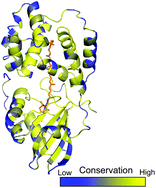The Orange CarotenoidProtein: a blue-green light photoactive protein
Abstract
This review focuses on the Orange

- This article is part of the themed collection: Blue-light photoreceptors
* Corresponding authors
a
Commissariat à l'Energie Atomique (CEA), Institut de Biologie et Technologies de Saclay (iBiTec-S), 91191 Gif sur Yvette, France
E-mail:
diana.kirilovsky@cea.fr
b Centre National de la Recherche Scientifique, UMR 8221 (CNRS), 91191 Gif sur Yvette, France
c United States Department of Energy – Joint Genome Institute, Walnut Creek, CA 94598, USA
d Department of Plant and Microbial Biology, University of California, Berkeley, CA 94720, USA
e Berkeley Synthetic Biology Institute, Berkeley, CA 94720, USA
This review focuses on the Orange

 Please wait while we load your content...
Something went wrong. Try again?
Please wait while we load your content...
Something went wrong. Try again?
D. Kirilovsky and C. A. Kerfeld, Photochem. Photobiol. Sci., 2013, 12, 1135 DOI: 10.1039/C3PP25406B
To request permission to reproduce material from this article, please go to the Copyright Clearance Center request page.
If you are an author contributing to an RSC publication, you do not need to request permission provided correct acknowledgement is given.
If you are the author of this article, you do not need to request permission to reproduce figures and diagrams provided correct acknowledgement is given. If you want to reproduce the whole article in a third-party publication (excluding your thesis/dissertation for which permission is not required) please go to the Copyright Clearance Center request page.
Read more about how to correctly acknowledge RSC content.
 Fetching data from CrossRef.
Fetching data from CrossRef.
This may take some time to load.
Loading related content
